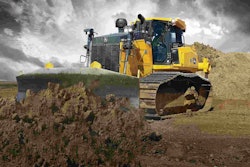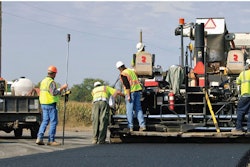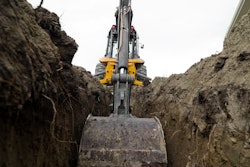
There’s no doubt that mastless is the way to go when it comes to GPS machine control. But until now, dozers have been the only machines to go mastless.
But on Monday, John Deere unveiled the industry’s first mast-free SmartGrade GPS control for motor graders on its G-Series motor grader line.
The first generation GPS machine control systems used two masts, typically about three feet tall, bolted upright to the top edge of the dozer’s blade or graders’ moldboard. The receivers on top of these masts then sent the GPS signals they received back to the cab via a string of coiled cable.
The arrangement worked, but the exposed masts, cables and components sat in a vulnerable position atop the blade and were targets for thieves. Unbolting and storing the masts was a daily chore, and damage from low hanging branches was a risk.
The mast-free arrangement replaces the mast-mounted receivers and exposed cables with two receivers on the top of the cab, inertial measurements units (IMUs) on the body of the machine and position sensing cylinders that control the blade. These include the two lift cylinders, circle sideshift, blade sideshift and pitch cylinders. The positioning information from these components is communicated to an on-board computer and run through sophisticated algorithms to determine the exact position of the moldboard in real time.
“The dual receivers give you direction sense and the ability to work on slopes much beyond what a single receiver can,” says Luke Kurth, motor grader product marketing manager for John Deere. “The in- cylinder sensors precisely measure length rather than motion and with that can calculate the position of the moldboard to within millimeters. By having all the components internal to the cylinder, they’re protected from external damage and don’t need to be calibrated.” Kurth adds.
The components communicate with the machine wirelessly and sophisticated algorithms combine the information from the receiver, IMUs and angle sensors to tell a computer inside the machine exactly where the machine and the cutting edge of the blade or moldboard in space, in real time.
As with the masted systems, these coordinates can be used to control the position of the blade automatically or give the operator a real-time view in the cab of the position of the blade relative to the design.
The company also announced a new automation suite option for its SmartGrade system for all graders. The automation suite reduces the number of controls the operator monitors with features like auto-articulation that combines front steering and rear articulation during blade flips without having to hold the control at the end of the pass. You can also activate multiple functions such as return-to-straight, auto-shift, and lights with a single button.

Mastless GPS control systems made their initial debut on dozers about three years ago. Deere introduced its first mastless 700K SmartGrade crawler dozer at the World of Concrete in 2016, which uses much of the same technology as found now in the SmartGrade G-series motor graders.
The company has since rolled out SmartGrade on four additional dozers, the 650, 750, 850 and 950 models. For more on how this technology works, see our article here.
GPS machine control gave dozers the kind of finesse that makes them suitable to function as finishing machines in some materials and applications. But the motor grader is still the king of the finishing machines, and with the elevation of the moldboard controlled by the GPS system motor grader, operators are better able to concentrate on things like blade pitch, circle side-shift and circle rotate, says Deere.










